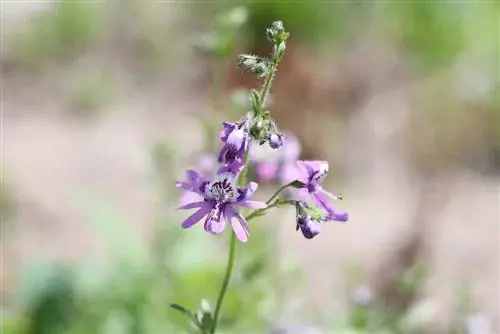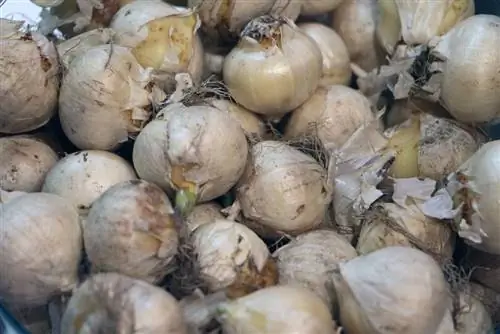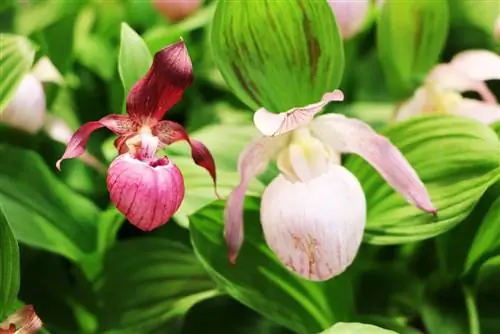- Author admin [email protected].
- Public 2023-12-17 03:39.
- Last modified 2025-01-24 12:45.
The farmer's orchid is wild in its beauty, original and comparatively easy to care for - this has made it very popular among hobby gardeners. As undemanding and versatile as the decorative plant is, care should still be coordinated. However, with the right knowledge, even beginners in plant care can easily do this.
Location
Part shade to light sun and always protected - this is what the location for the farmer's orchid should look like. The split flowers cannot tolerate waterlogging, such as locations with high groundwater or proximity to bodies of water. Neither are very windy places or depressions in which cold air collects. Places protected from the wind on the balcony or in the garden that are shaded by walls, fences or taller plants are ideal.
Substrate
The farmer orchids are not very picky when it comes to substrate. The soil should be nutrient-rich and permeable and not prone to compaction. The following are therefore well suited:
- Garden soil that has been enriched with mature compost or manure
- Pre-fertilized balcony potting soil
- Nutritious soil that has been loosened with sand, gravel or perlite
These requirements apply to both outdoor planting and container cultivation.
Plants
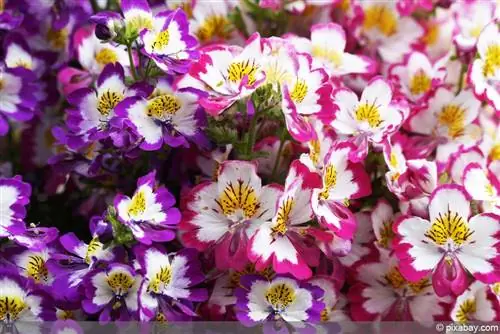
When planting, you just have to pay attention to the temperature, because the farmer's orchid cannot tolerate frost. It should therefore not be planted in the bed too early. When planting the schizanthus, it is important that the location is selected appropriately and prepared with the appropriate soil, fertilizers or loosening additives and that the timing is chosen correctly.
The split flower is not allowed in the bed before the last late frosts in May or June. In the pot, the nightshade plants are allowed outside from March or April - but only during the day. At night they have to be brought back into the house for protection.
Pouring
The farmer's orchid needs a lot of water, especially during the flowering period. However, it cannot tolerate waterlogging. It is therefore important to have coordinated watering, where the following points are taken into account:
- Never allow the substrate to dry out completely, only allow it to dry superficially
- Avoid waterlogging, ensure good water drainage
- Do not water from above, leaves and flowers suffer from direct contact with water
Tip:
When it rains heavily in summer, the flowers often look damaged and the plant as a whole looks sick. This is usually due solely to direct contact with water and is no cause for concern as long as the soil is permeable and drainage is ensured.
Fertilize
What is a lush display of flowers for the observer is a great effort for the farmer orchid. This is only possible if the schizanthus has sufficient nutrients available.
Therefore, on the one hand, the substrate should be nutrient-rich and, on the other hand, it should be fertilized at least during the flowering period. Liquid fertilizer is given every two weeks.
Tip:
Mixing the liquid fertilizer with the irrigation water ensures an even distribution of nutrients and prevents chemical burns on the roots.
Blend
The farmer's orchid does not need a cutting, but it benefits the flowering power and can stimulate the split flower to a second flowering phase. The important thing is:
- Remove wilted and dried flowers as quickly as possible
- Cut immediately after the first flowering phase
- Short shoots by a third after flowering
- Use clean and sharp cutting tools
Tip:
If you immediately remove withered flowers and shoots, you will gradually trim the farmer's orchid. This is gentler on the plant and continuously stimulates the formation of new flowers.
Bucket Culture
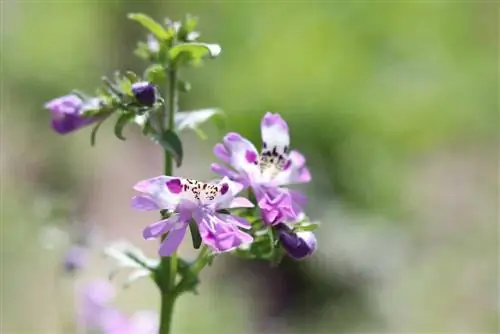
The farmer's orchid can easily be cultivated in a pot, but requires appropriate care. The following factors are crucial here:
- Loose, nutrient-rich soil
- Secured water drainage
- Pour “from below” directly onto the ground or into the saucer or planter
- Stay indoors when temperatures are below 10°C
The last point in particular is an advantage. If the split flower has not been planted outdoors, it can easily be moved to a more protected location when temperatures are low or there is constant rain. However, more care must be taken to ensure that the water can drain away and fertilization must generally be carried out more frequently.
Wintering
Opinions differ here when it comes to the farmer's orchid. Some believe that with proper overwintering, the schizanthus can be cultivated for two years. Others think this is impossible. So it seems to be a matter of trying. It is known that the farmer orchid is not frost hardy. This means that it cannot survive the winter in a temperate climate - even if it is mild. However, there is still the possibility of saving the plant over the cold season or finding a replacement in good time.
The first option is to bring the farmer's orchid indoors in late summer or early autumn and place it in a bright room where the temperature is between 10 and 18°C. Fertilization must be stopped. However, you should still prevent the substrate from drying out completely. The second option is to obtain seeds from the farmer's orchid and thereby multiply and maintain them instead of overwintering them.
Propagate
The farmer's orchid can be propagated from seeds. To do this, simply leave a few withered flowers on the schizanthus so that seeds and fruiting bodies can form. These are removed in late summer or early autumn and the seeds are carefully removed from them. They are stored in a dry and dark place over the winter.
The procedure described below is important and helpful:
- Between February and March, the seeds can be sown on potting soil or the substrate described above and only lightly covered with it. If well moistened and placed in a bright, warm place, they will usually germinate within two weeks.
- In order to germinate, the seeds of the farmer's orchid need as constant a supply of liquid and moisture as possible. The easiest way to achieve this is to moisten the substrate and then cover the cultivation container with foil or a transparent pane. To avoid mold, the cover should be removed at least once a day for a few minutes. This allows excess humidity to escape and dry condensation.
- Under optimal conditions, the seeds begin to germinate after about two weeks.
- When the seedlings reach a height of five centimeters, they can be separated, repotted and one to three plants can be used per container.
- Fertilization can begin after eight weeks. As with germination and adult farmer orchids, the water supply should be designed to prevent the substrate from drying out - but at the same time to prevent waterlogging.
Caution: Toxic
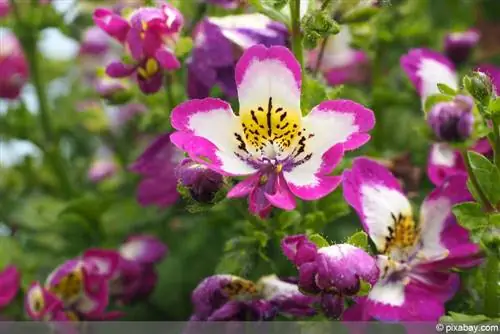
Like many other nightshade plants, the farmer's orchid is poisonous in all parts. In households with small children or pets, planting the split flower should therefore be carefully considered.
Typical care errors, diseases and pests
The farmer's orchid is very robust against pests due to its toxicity, but can be susceptible to fungal diseases if care is made incorrectly. Substrate that tends to compact and waterlogging are the most common causes, while rot is a typical consequence.
If you make sure that the culture conditions are right in advance, you have already taken the best preventative measures. If such a disease has broken out, removing the affected parts of the plant, moving the plant into fresh, permeable substrate and using fungicides can provide relief. However, there is no guarantee that the farmer orchid will be successfully saved.

